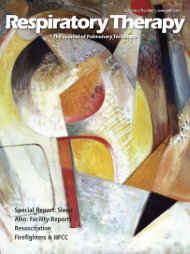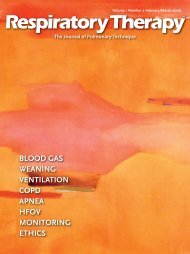RT 02-03 JJ07 main web - Respiratory Therapy Website
RT 02-03 JJ07 main web - Respiratory Therapy Website
RT 02-03 JJ07 main web - Respiratory Therapy Website
You also want an ePaper? Increase the reach of your titles
YUMPU automatically turns print PDFs into web optimized ePapers that Google loves.
PRODUCT CASE STUDY<br />
The Flow Characteristics of the VO<strong>RT</strong>RAN<br />
E-Vent Case Manifold System<br />
Introduction<br />
During the national statewide disaster drills, many health care<br />
facilities realized the finite limit of ventilators determines the<br />
number of patients that can be managed in any mass casualty<br />
incident (MCI). Under the Hospital Preparedness program, the<br />
bureau awards grant money to states who allocate, to as many<br />
hospitals as possible within the designated regions, to<br />
strengthen the ability of hospitals and other health care facilities<br />
to respond to bio-terror attacks, infectious disease outbreaks<br />
and natural disasters that may cause MCI.*<br />
It is recognized, that the VO<strong>RT</strong>RAN Automatic Resuscitator<br />
(VAR), a pneumatically driven automatic resuscitator, provides<br />
the best clinical options as to location (not all triage sites have<br />
A/C power), portability, relative ease of use and the most cost<br />
effective way of providing basic mechanical ventilation to a<br />
large number of patients.<br />
Packaging the VARs in the VO<strong>RT</strong>RAN E-Vent Case (Figure A),<br />
with all your emergency procedures and supplies, allows for<br />
rapid emergency ventilator deployment in any MCI.<br />
The E-Vent Case gas distribution manifold system is engineered<br />
specifically for operating multiple VARs from a single gas source<br />
(oxygen, compressed air or oxygen enriched air). For added<br />
robustness while operating in the field, the manifold is mounted<br />
on a sturdy stand. The manifold inlet is connected to the gas<br />
source via a twenty foot (20’) heavy duty oxygen hose. The<br />
supplied gas pressure is adjustable using the manifold mounted<br />
pressure regulator and pressure gauge. Each of the seven (7)<br />
outlets is fitted with male thread oxygen DISS fitting with auto<br />
shut off. The manifold system can support up to seven VARs<br />
operating from the single gas source. The VAR is a completely<br />
pneumatic driven resuscitator that runs on a continuous flow of<br />
compressed gas. Typically, hospital supplied gas is regulated to<br />
50 PSIG and the system is capable of providing sufficient flow<br />
to meet the demand of medical equipment.<br />
However, in the emergency situation, with limited resources,<br />
preparing for an emergency means knowing the capacity and<br />
Figure A -<br />
E-Vent Case<br />
packages with<br />
the VARs<br />
limits of your facility. Understanding your gas supply is essential<br />
in determining the numbers of surge capacity ventilator patients<br />
the facility can manage. The VARs and E-Vent Case offer tools to<br />
help you meet your needs but it is not the complete solution.<br />
You also need trained clinicians and sufficient gas resources.<br />
This report details the flow requirements and operational<br />
characteristics of the VARs using the E-Vent Case manifold<br />
system. Using the flow requirement information provided<br />
herein, there are many alternative gas distribution systems that<br />
the hospital’s biomedical department can develop to achieve the<br />
same result. To safely and effectively operate multiple VARs<br />
from a single gas source, make sure your gas distribution can<br />
provide the flow (liters per minutes) to meet the demand.<br />
Setting up the manifold<br />
Setting up the E-Vent Case manifold distribution system for<br />
multiple VARs is easy. Follow the five quick steps [1] – [5]:<br />
1 Connect to a gas source. Connect the other end of tubing to<br />
manifold inlet (Figure B).<br />
2 Set patient flow to 25 LPM with pressure gauge at 25 PSIG<br />
(Figure C).<br />
3 Connect patient (Figure D).<br />
<strong>Respiratory</strong> <strong>Therapy</strong> Vol. 2 No. 3 � June-July 2007 35











